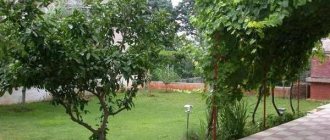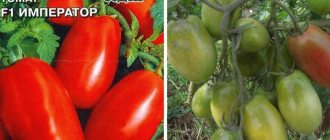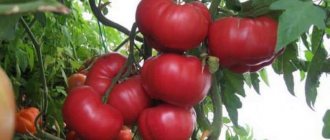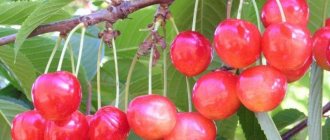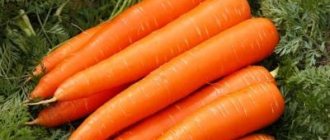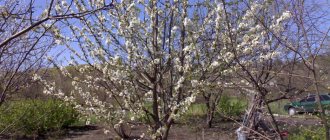Astakhova cherry belongs to the northern varieties. The goal of breeding was to create cherries that were resistant to harsh climates. Gardeners succeeded in this to the fullest: the combination of sweetness characteristic of southern varieties, high immunity to disease and resistance to cold make the Lyubimitsa Astakhova variety the optimal choice for the central territories of the country.
History of variety selection
Breeder M.V. Kanshina is the creator of the cherry Lyubimitsa Astakhova, who gave it the name in honor of her husband A.I. Astakhov. The developed variety belongs to the northern group: winter-resistant, highly productive. The final work was carried out in the 70s under the guidance of prof. A. N. Venyaminova in Bryansk. The Lyubimitsa Astakhova variety was created on the basis of selected samples of hybrids, and its genotype was formed under the influence of Voronezh and Leningrad selections. In the State Register since 2011.
Diseases and pests
Cherry in general is a fairly disease-resistant tree, and the Lyubimitsa Astakhova variety practically does not get sick. It has average resistance only to coccomycosis; its resistance to other diseases is considered high. However, in early spring, before the buds swell, trees are sprayed with 1–2% Bordeaux mixture for preventive purposes: after all, coccomycosis is a dangerous fungal disease. If it becomes attached, it will be more difficult to fight; the diseased tree quickly weakens and may die.
Coccomycosis begins as seemingly harmless spots on the leaves, but quickly affects the entire tree.
Among the pests, the cherry fly is considered the most dangerous. This is the same fly whose larvae are the “worms” that we find in the fruits of cherries and cherries. When a fly infestation occurs, a significant portion of the crop can be destroyed. Digging the soil and timely removal of carrion significantly reduces the number of pests. The fly flies well on bait (compote, kvass), and this is another harmless way to fight it.
The cherry fly lays many eggs, from which larvae hatch and infect the fruit.
They try not to use chemical insecticides on cherries, but for such a late variety as Lyubimitsa Astakhova, this can in principle be done. Among the approved drugs are Phasis and Actellik. Spraying trees of this variety is possible even at the stage of ovary formation, but insecticides should be used only in cases of extreme necessity and strictly according to the instructions, observing all safety measures.
Description of the cherry variety Lyubimitsa Astakhova
The main indicators of Lyubimitsa Astakhov are presented in the table:
| Regions | |
| Regions for Astakhov cherries | Central, but also thrives in the Non-Black Earth Region, in the Southern Urals. |
| Tree | |
| Trunk | Average growth rate; Height 3.5 – 4 m. |
| Bark | Rich gray, closer to dark, with slight flaking; after the leaves fall off - very silvery. |
| Leaves | Matte, green; medium, long, elliptical, pointed with jagged edges. |
| Flowers, fruits | Bouquet branches; three saucer-shaped flowers in an inflorescence and a cup in the form of a glass. |
| Crown | Spreading, medium density, round-oval. |
| Escapes | Below are located horizontally, bare, brown-gray. Closer to the top they are inclined and brown. |
| Formation | By pruning, tiers are created |
| Fruit | |
| Size | Average |
| Form | Oval |
| Weight | 4–5 g, maximum up to 8 g. |
| Skin | Dark red, closer to black-burgundy in ripe fruits, smooth, with a sheen, no subcutaneous dots. |
| Pulp, juice | Brightly colored; The pulp is elastic, fleshy, rich in juice, with an easily separated bone. |
| Taste | Sweet, like the best varieties in the south, tasters score from 4.5 to 4.8 out of 5. |
We organize competent care
To obtain a strong, strong tree that bears fruit abundantly, it is necessary to carry out a number of measures to care for it.
Feeding and watering
Cherries do not like excess moisture, so the tree is watered 4-5 times during the season. In particularly dry regions, watering is carried out more often, as needed. For active growth and abundant harvest, the fruit crop needs fertilizers and fertilizing, which must begin in the 2nd year of the plant’s life.
In the spring, cherries are fertilized with organic matter and nitrogen fertilizers, which help the plant recover from the winter period and promote development during the growing season. During abundant flowering, the tree needs phosphate and potassium fertilizers, which are usually combined with irrigation work.
Weeding and loosening the tree trunk circle
Caring for the tree trunk consists of thoroughly loosening the soil and mulching with dry grass or sawdust. Once every 3 years, the soil around the tree trunk is dug up and compost is added to it. Also, the tree trunk circle is completely cleared of weeds that interfere with the normal growth of the tree. Shaping and trimming
Sanitary pruning is carried out in spring and autumn. Its goal is to free the tree from frozen, broken, dry and diseased branches. Formative pruning is done annually in the spring, while the buds have not yet swelled. Every year, the strongest and densest branches are selected, which will form the tiers of the plant. All other layers are cut off.
Timely pruning of cherries not only increases its fruiting, but also protects against the spread of diseases and pests.
Preventative treatment
Before the onset of the growing season, Lyubimitsa Astakhova cherries are sprayed with a urea solution or special preparations that can resist the spread of fungal diseases and destroy pest larvae.
Bark protection
After spring and autumn pruning, the trunk and bark of the tree are protected by whitewashing, which saves the plant from sunburn and the development of various putrefactive processes.
Preparing for winter
Before wintering, the tree is watered abundantly. This procedure provides additional protection to the root system from freezing.
Young trees are wrapped in burlap or any other materials that have a natural base and will not block oxygen access to the plant. In regions with frequent snowfall, a snowdrift is made around the plant, which protects the fruit crop from freezing.
Characteristics of the variety
The description of the variety includes several points of characteristics, all of them together constitute the advantages and disadvantages of Astakhov cherries.
Winter hardiness of cherries Lyubimitsa Astakhova
Increased resistance to frost and cold. The Lyubimitsa Astakhova variety was specially created in harsh climate conditions. Still, for better yield, it is advisable to plant it in places with protection from the wind; it is recommended to create protective fences on the north and south sides.
Cherry pollinators Lyubimitsa Astakhova
The variety is partially self-pollinating, so the presence of pollinating trees nearby is mandatory, since without them there are very few ovaries. In extreme cases, cherries that bloom at the same time as Astakhov’s Favorite can serve as pollinators.
Advice! The recommended distance from Astakhov cherries is 7–10 m. For cross-pollination, it is better to plant 2–3 different varieties. To save space on the site, sometimes a pollinator cutting is grafted into its crown.
Terms of flowering and fruiting of pollinators for cherries Lyubimitsa Astakhova:
| Variety | Flowering/fruiting |
| Baby | From 10 May / mid July |
| Tyutchevka | End of May / end of July |
| And the way | Late March/early summer |
| Red hill | Early May/mid June |
| Ovstuzhenka | Second ten days of May / mid-summer |
| Raditsa | Late March/early summer |
| Large-fruited | Late May/end of summer |
| Revna | Mid May/July |
Productivity and fruiting
The flowering time of Astakhov's Favorite is May. Fruiting begins in the 5th year. The ripening period is medium-late (early – mid-July).
Attention! The yield of Astakhov cherries is closer to high levels: mature cherries produce 10 kg of berries. Fruiting is regular and there is no dependence on periodicity.
Area of application of berries
The use of Astakhov's Lyubimitsa berries is universal. Safety during transportation is good, as the fruits are dense. The best time for collection is early in the morning, as at this time the pulp has good density.
Under normal conditions, the berries do not last long (2–3 days). Store in the refrigerator.
Suitable for all methods of use: fresh, freezing, drying, jam, twists, compotes, baked goods, juices, fruit salads.
Resistance to diseases and pests
Diseases of Lyubimitsa Astakhov:
| Disease | Immunity |
| Coccomycosis | Average |
| Moniliosis | High |
| Clusterosporiasis | High |
| cherry fly | Affects fruits, resistance is average. |
Despite the high degree of resistance to fruit diseases, gardeners recommend that preventive measures be taken when growing Astakhov cherries.
Advantages and disadvantages of the variety
Pros and cons of Astakhov's Favorite:
| Advantages | Flaws |
| Resistant to cold and frost. Resistant to frosty wind, but within reasonable limits. | Selection of pollinators. |
| Sweet taste of southern varieties (4.5 - 4.8 out of 5 on the tasting scale). | Vulnerability to frost in spring, especially in young seedlings. It is recommended to wrap them up. |
| High yield. | |
| Excellent immunity. | |
| Unpretentiousness. |
Advantages and disadvantages
The advantages of the Lyubimitsa Astakhova cherry variety include the following positive characteristics:
- winter hardiness down to -30°C;
- annual average yield;
- preservation of appearance and taste during transportation to places of sale and processing;
- high appreciation of the gastronomic and aesthetic properties of fruits;
- high degree of immune protection against diseases and pests.
Among the shortcomings, gardeners in the Central region note:
- the need to plant 1–2 trees of other varieties for pollination;
- freezing of flowers during late spring frosts.
The small number of disadvantages of the crop, the unpretentiousness of the tree to growing conditions and the high tasting assessment of the fruits have made the Lyubimitsa Astakhova cherry variety a welcome guest in the gardens of the Central region.
Landing Features
When planting Astakhov cherries, the following parameters are taken into account:
- deadlines;
- priming;
- watering;
- place of growth;
- distance from other plants and proximity to them.
Recommended timing
Astakhov cherries are planted in late spring, after thawing, but before buds open, after the possibility of late frosts has been minimized and the soil is well saturated with moisture. Autumn planting carries the threat of freezing of immature roots.
Advice! The spring planting period for Astakhov cherries is preferable.
Choosing a suitable location
For Astakhov cherries, you need to choose the warmest place on the site, open to light, protected from north winds by a wall, fence, or other plantings. On the slope, the south side is the most favorable.
Important! There should be no high groundwater (from 1.5 m). Astakhov's cherry tree does not tolerate swampy soils. If there is a risk of flooding, the tree is planted on an embankment.
Soil requirements: non-acidic, fertile and at the same time well breathable (loose). Clay and sandy soils are undesirable for cherries.
What crops can and cannot be planted nearby?
- Sweet cherry Lyubimitsa Astakhova does not favor the neighborhood with peppers, tomatoes, eggplants, tobacco (nightshades). They are susceptible to verticillium wilt, which can also destroy cherries.
- The Astakhov cherry feels great next to the small periwinkle, violets, lily of the valley and other flowers that love light sandy loam soils.
- It is not recommended to plant apple, pear, apricot, peach, currant, raspberry, gooseberry, and hazel trees nearby.
- But black elderberry (additional protection against aphids) and columnar cherry plum, on the contrary, have a good effect on cherries.
Important! Do not plant trees nearby that are prone to strong branching of roots: linden, oak, birch.
Selection and preparation of planting material
Requirements for Astakhov cherry seedlings:
- no more than 3 years;
- no damage to the root and bark;
- there should be no spots or cracks that are not characteristic of the plant;
- the root should have at least 3 branches with a thickness of 2 mm.
Preparation:
- Damaged root segments are trimmed.
- The root is soaked if it is excessively dry.
- Remove all leaves as they absorb moisture.
Landing algorithm
Step-by-step actions for planting cherries Lyubimitsa Astakhova:
- They dig a hole, fill it with humus, ash, and fertilized soil mixture (half of the nutrient soil). Depth – 40–50 cm, diameter – 80 cm.
- They make a mound at the bottom, install the tree, and arrange the roots conveniently. Then, lifting it by 5 cm, carefully fill in the fertilized soil mixture.
- The neck of the root is on the south side, protruding 3-4 cm above ground level so that the grafting site warms up well.
- An excessively flaccid crown is cut down to living tissue, but no more than a third.
- The trunk is tied to a peg until the tree grows.
- pour out 2 buckets of water and mulch immediately.
Harvesting and storage
Harvesting various berries can be done in two ways:
- milking - the berries are collected in a waterproof apron, after which they are carefully poured into a prepared container lined with paper;
- by cutting - the fruits are cut off with part of the stalk, which significantly increases their transportability and shelf life.
Did you know? Cherries can be used as food coloring. However, contrary to expectations, the color of the dye will be green, not red.
When choosing the time for harvesting, you should take into account the fact that it is very easy to “miss” cherries - a delay of just a few days can lead to the berries falling off or being spoiled by birds. Almost the only reason to delay picking berries is rain, since wet berries can easily spoil during storage. But there is no need to rush either, since the picked cherries do not ripen. The optimal time for harvesting is in the morning, but after the dew has dried.
The shelf life level of Lyubimitsa Astakhov is low - if stored in a cellar or refrigerator at an air temperature of +1...+5° C, cherries can last for about two weeks (if the berries were collected by shearing). You can slightly extend the shelf life by using plastic containers or hermetically sealed bags as the main container. In other cases, if you want to preserve the cherries longer, you can use freezing.
It is not for nothing that the Lyubimitsa Astakhova cherry is widely popular among gardeners - its high taste, ease of care, regular rich harvest and, most importantly, high frost resistance make this variety one of the few that are suitable for owners of summer cottages located in different climatic conditions.
Aftercare for cherries
| Watering | Once a week in a hole near the trunk, for an adult tree - in a furrow, during the ripening of the crop: 3-4 buckets per week (during drought). |
| Top dressing | The next year after planting. Fertilizers: in spring - nitrogenous; · flowering and a little later - potassium; autumn - fluorine-containing. When it begins to bear fruit, this is done regularly. |
| Trimming | It is poorly tolerated and is kept to a minimum. Remove vigorous, dried and damaged branches and sprouts at the roots. After the berries appear on the shoots, they are shortened by a third - this stimulates the appearance of fruitful buds. In the northern regions, it is undesirable to carry out these manipulations annually. |
| Preparing for winter | The soil is mulched. Seedlings up to 3–4 years old are wrapped in spruce branches, roofing felt, and lutrasil. |
| Reproduction | Vaccination. The best rootstocks are low-growing, winter-hardy and adapted to the terrain. |
Diseases and pests, methods of control and prevention
Before the buds swell, spray with Bordeaux mixture or copper sulfate. This is repeated during the flowering period. Treatment with Zircon and Ecoberin is recommended.
The cherry fly is the most dangerous pest. To prevent its appearance, fallen berries need to be picked regularly, and during flowering the crown is treated with insecticides.
Important! The wounds are treated with garden ointment, the trunks and forks are treated with white garden paint with insecticides.
Reproduction
A common method of propagating cherries is by grafting. Winter-hardy low-growing varieties of cherries, cherry plums, plums, and cherries are chosen as a rootstock. Cuttings 15 cm long are cut in the fall. In the spring they are grafted onto the rootstock using various methods - in a split, behind the bark, or by budding.
A less productive method of propagating Lyubimitsa Astakhova’s cherries, but used by gardeners, is cuttings.
Cuttings 15 cm long for planting in a greenhouse are cut at the beginning of summer from the branches of the first tier. The lower leaves are removed, leaving 2 leaf blades at the top. Overnight, the resulting material is soaked in Kornevin’s solution. In the morning, the cuttings are planted in a soil mixture consisting of equal parts of garden soil, sand, humus, deepened by 3 cm. A distance of 6 cm is maintained between plants in the row and between rows.
In the spring of next year, the seedling is transplanted into a garden bed for growing. After another year they are planted in the garden.
Reviews from summer residents about the variety
Maria Vasilievna, Kaluga.
Four years ago I persuaded my husband to buy seedlings of Astakhov’s Lyubimitsa, and did not regret it for a day. The first harvest has already been harvested. The berries are tasty, juicy and sweet. We eat mostly fresh, but in the future I plan to make compotes and jams.
Egor Petrovich, Vladimir.
Several years ago, the nursery advised me to buy a new cherry variety, Lyubimitsa Astakhov. The yield is excellent, does not require special care, and is resistant to diseases.
General information about culture
This cherry was bred in Bryansk at the local lupine research institute, where specialists created many new varieties of fruit trees (including stone fruits). The author and originator of the Pamyat Astakhov cherry is the breeder Kanshina M.V. It was based on varieties grown in the Voronezh and Leningrad regions. This variety was named after the husband of the creator of this cherry.
Do-it-yourself manual potato planter from a bicycle frame. The process of making a potato planter for a walk-behind tractor with your own hands. || Convenient design for planting potatoes
The variety was tested, was included in the State Register in 2011 and zoned for cultivation in the Central region and other regions of our country with a similar climate.
Origin and region of cultivation
The Bryansk Research Institute of Lupine is an innovator in the development of new varieties of fruit plants, and the leading role in the development of the cherry variety Lyubimitsa Astakhova belongs to the famous breeder - Academician Kanshina.
The cherry tree got its name thanks to her husband, the famous scientist Astakhov. Another name for the hybrid variety of this cherry is “In Memory of Astakhov”. A new frost-resistant type of cherry was registered in 2011 and is recommended for cultivation in the central regions of the country, the Urals, the Non-Black Earth Region and the southern regions. The new hybrid was bred from Leningrad and Voronezh plant varieties.
Therefore, gardeners in the Moscow region now grow fruit crops in gardens and vegetable gardens with great pleasure.
More details about cultivation
Scheme (photo):
The key to a good cherry harvest is a successful location of the tree. The most suitable place is a well-lit, sunny place protected from the north wind by a wall or fence. The variety will develop well in the southern part of the site.
Cherries do not tolerate swampy places. If the groundwater is high and there is a risk of flooding, it is planted on an embankment.
For Lyubimitsa Astakhov, fertile soil is suitable, not acidic, breathable. This can be achieved by planting green manure plants in the ground, applying organic fertilizers, and mulching.
The variety is propagated by grafting, but it is better if the rootstocks are short, then short trees are easier to protect from frost. A winter-hardy rootstock adapted to the terrain will guarantee the longevity of the tree.
Varietal cherries can be purchased in nurseries, at thematic exhibitions and fairs (“Vegetable Garden”), and in specialized stores. If you plant trees in the fall, there is a high probability that the fragile roots will freeze in winter. If you purchase planting material in the fall, it is better to save the seedlings until spring, burying them in the basement. It is better to plant them in the spring, when the earth has already melted, but the buds have not yet bloomed.
The hole for planting cherries should be about 80 cm in diameter and about half a meter deep. You can prepare it in the fall. When planting, you need humus and ash as fertilizers. They can make up half of the soil mixture; in the future, the seedling will have something to eat.
When planting, the roots are carefully straightened and covered with soil. The tree is placed so that the root collar is on the south side (this way the grafting site will be warmed up more by the sun) and 5 cm higher above the ground level. If the root collar is buried, the plant may be stunted in growth, and the yield will be low.
Fertilizers
Nitrogen fertilizers are used in the spring, potassium fertilizers are used during flowering and a little later, and phosphorus-containing fertilizers are used in the fall. Before winter or early spring, trunks and forks are whitened with garden paint with the addition of adhesive and - sometimes - insecticides. To combat diseases and pests, the crown is sprayed prophylactically with chemical solutions.
If necessary, sanitary and thinning pruning is done, and after fruiting the shoots are shortened by a third to stimulate the formation of flower buds for the next year.
